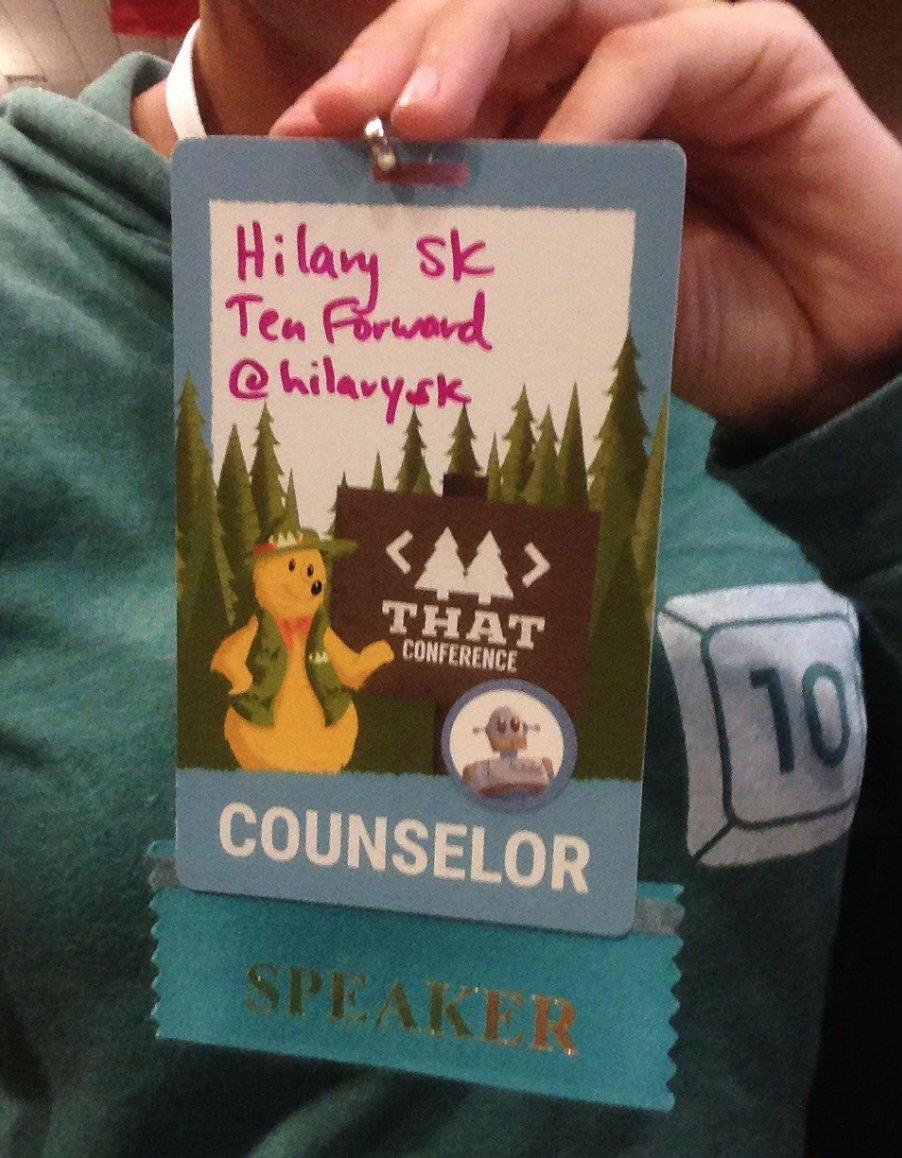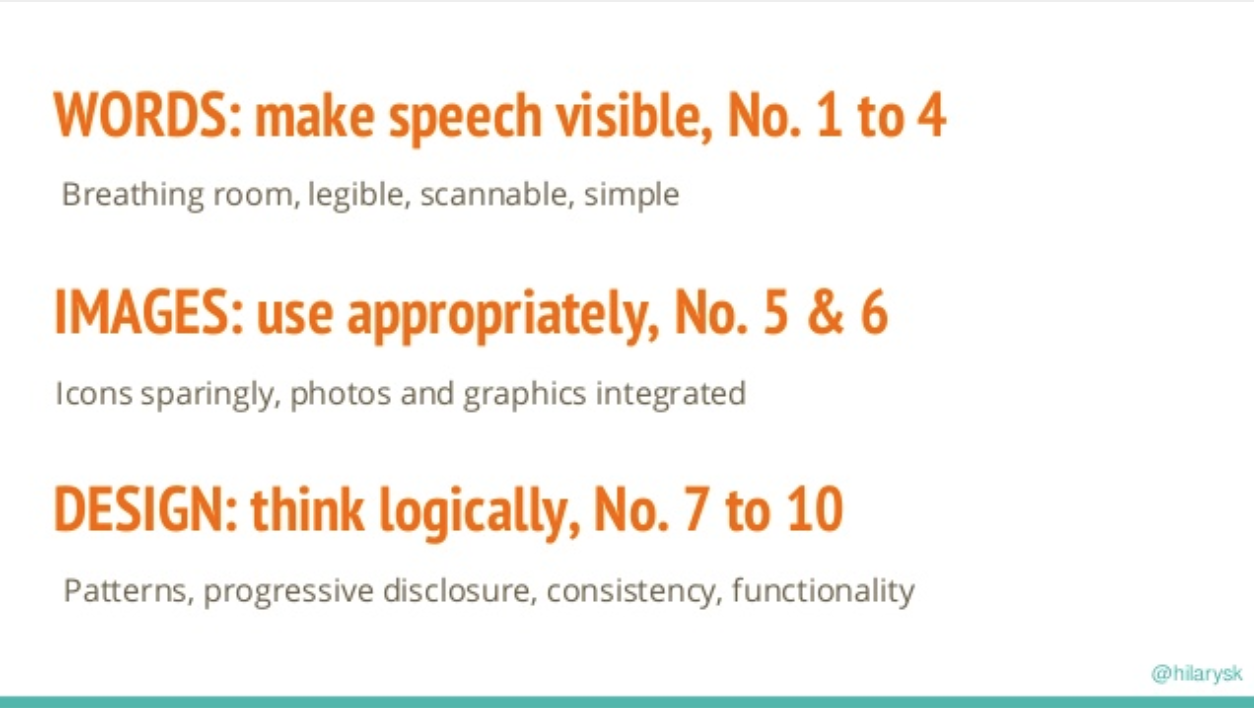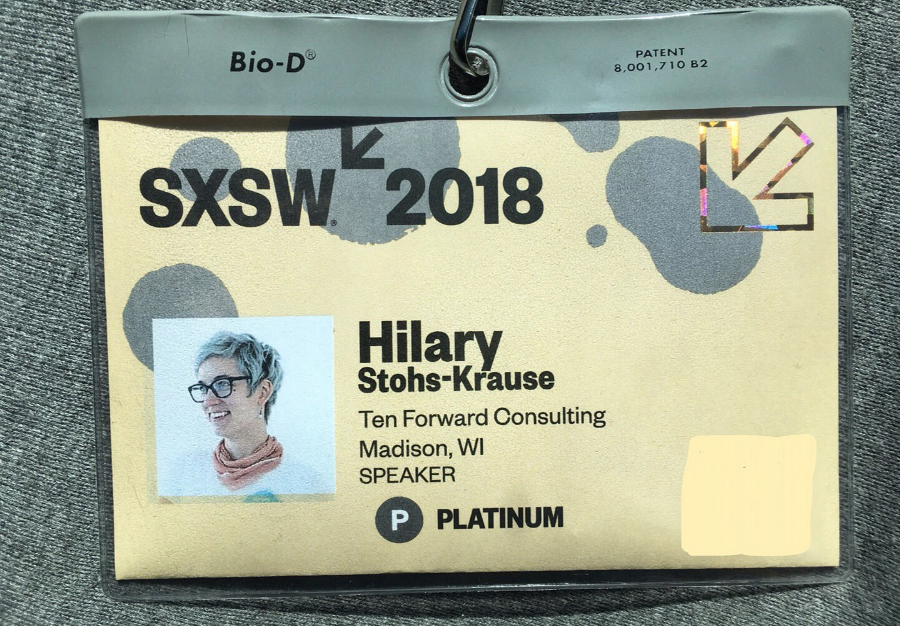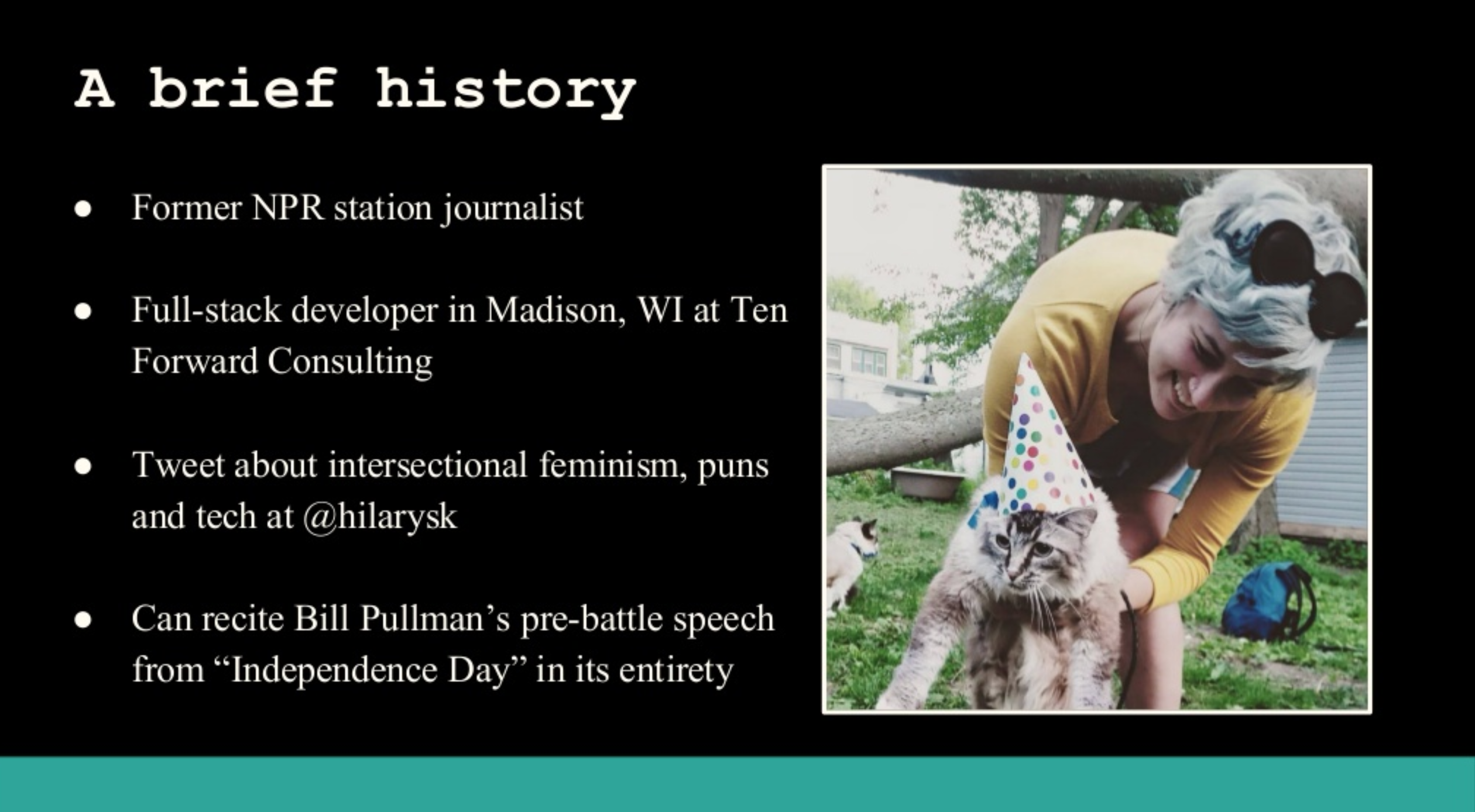On public speaking and Lara Hogan's fantastic book
A little lunch break reading, courtesy of @lara_hogan, just in time for what feels like peak CFP season. #womenintech #vacationandlearn #publicspeaking pic.twitter.com/ebwcruOVq3
— Hilary Stohs-Krause (@hilarysk) January 9, 2018
I first read Lara Hogan's 2016 book "Demystifying Public Speaking" this winter, but recently pulled it back out to help prep for a session I'm co-leading for MadRailers on submitting to conferences.
If you're thinking of trying your hand at speaking, or even if you've done some public speaking before, I definitely recommend Lara's book. It's thoughtful, well-laid out and compact, with sections on choosing a topic, writing the presentation, practicing your talk and more.
Interspersed throughout are numerous helpful tips and reminders; below are a few that resonated with me, either as new ideas or reinforcing what I've already learned.
Enjoy! (And go buy Lara's book!)
Have clear takeaways
Check your topic’s potential by naming concrete takeaways, identifying a story structure, and testing your topic against constraints like talk format or time slot.
...
Nailing down the bigger idea - what I wanted the audience to leave with and think about after they went home - was crucial to making my presentation memorable.
Lara Hogan, "Demystifying Public Speaking"
This is a big one: If I can’t list at least three specific things the audience will learn, it’s probably not going to work as a standalone talk.
"Don’t discount intro-level talks."
I was talking with a colleague about this just the other day. There are so many things related to tech that I’d love to learn, but aren’t high enough priority to spend my precious free time on (especially if they’re not directly related to my job). If I’m at a conference, however, and there’s a 101 talk on, say, the basics of game development, sign me up!
"Give yourself permission to be anxious."
This truth can’t be repeated enough. Almost everyone gets nervous; I'm cool as a cucumber until the 10 minutes before my talk, and then I'm a total wreck right up until I begin my presentation.
Experiencing anxiety is normal; you just have to figure out the best way for you to handle yours (for me, it's talking waaaaay too fast to any friendly stranger about anything EXCEPT my talk).
“My favorite way to vet a potential topic is to write about it.”
In my experience, this goes both ways - sometimes, I write a blog post about a topic to see if it has legs; other times, I flesh out a blog post I've already written into a conference talk.
This gets you thinking about the topic in a logical, narrative manner, and even if you end up deciding it's too thin for a talk, you still get a fresh new piece of writing out of the deal.
Speaking & payment
 Unfortunately, one of the sites Lara included in her book regarding “who pays tech speakers” appears to be no longer maintained. The other, however - “A Formula for Speaking Fees” by Jenn Lukas - is alive and kicking, and a quick but insightful read.
Unfortunately, one of the sites Lara included in her book regarding “who pays tech speakers” appears to be no longer maintained. The other, however - “A Formula for Speaking Fees” by Jenn Lukas - is alive and kicking, and a quick but insightful read.
I’d also add “Getting Funding to Attend and Speak at IT Conferences” by Adele Shakal, which is more resource-oriented and starts with Adele’s personal story.
It's always good to double-check if the conference covers travel and/or accommodation (or provides an honorarium) before submitting your talk.
At this point in my career, having done public speaking for not quite two years, any speaker fee on top of travel and lodging feels awesome. At the very least, I expect a comped ticket to the conference - if they can’t even do that (I’m looking at you, past Grace Hopper Celebration policy), then I’m out. Because for real.
"Just because an event has accepted your proposal, it doesn’t mean you must say yes."
This is one I wish I'd known sooner.
Submitting to a call for proposals (CFP) is kind of like going on a first date - even if the other person follows up for a second date, you don't have to say yes if you’re just not feeling it, or if you already committed to doing something else that night.
It’s important to note that some conferences indicate they fully expect CFP submitters to be available, and make you check a box acknowledging this; in my experience, however, it’s not the norm.
Choose your images deliberately.
Are you showing people who are different from you? Are you showing a variety of people doing different things? Are you actively trying to challenge our stereotypes and biases?
Lara Hogan, "Demystifying Public Speaking"
Some resources to help with this include:
- Pexels - Public domain
- WOCinTech Chat Flickr - Free to use with attribution
- Representation Matters - Pay to use, but with free images emailed every month
“Set expectations for your audience upfront, so they have their ears and brains open to your content.”
 This might seem like a small thing, but it makes a giant difference.
This might seem like a small thing, but it makes a giant difference.
For example, I’m a notecard person - I use a lot of statistics in some of my talks, and I want to focus on the presentation, not trying to remember which study came from which institution which year. Lara suggests stating things like this at the beginning of your talk, which normalizes it and keeps it from being a distraction (for you or for them).
I also like to provide an outline of my talk at the beginning, so folks know what to expect content-wise. This helps people determine if they’re actually interested in my talk (so that if they're not, they can switch over to a different one), and alternatively, it can keep folks around who would get something out of the latter half and might otherwise have left during the first half.
“Little interactions sprinkled throughout a talk helps significantly with keeping folks’ attention.”
This is something I could definitely improve in my presentations; I think it could help to take even just half an hour once I’ve written a draft of a talk to brainstorm how I can add in audience interactivity.
Feedback
Lara includes a thoughtful section about how to receive (and give) feedback, particularly regarding public speaking.
If you see feedback criticizing you as a person, policing your tone, or otherwise providing unhelpful advice, chuck it in the garbage.
Lara Hogan, "Demystifying Public Speaking"
Two tips that stood out to me:
1. Ask about any slang or jargon that they couldn’t understand
I use the phrase “How to stay woke” in one of my talks, and the first time I presented it, an older audience member came up afterwards and asked if "woke" were an acronym for something, much to my chagrin.
No one wants to feel like they don’t get the joke or don’t understand something; now, when I give that talk, I take a quick second to explain what "woke" means.
2. Open private feedback with a question, like “How do you feel you did?”
This approach is more engaging, and helps keep the person on the receiving end from feeling attacked or defensive.
It gives them a chance to reflect, and maybe even realize [where they could improve] on their own - a win-win for everyone.
Lara Hogan, "Demystifying Public Speaking"
"It is absolutely fine to say ‘I don’t know’ when you’re onstage."
This one always bears repeating: You don’t know everything. How could you?! And that’s totally fine.
Lara lists a few ways to respond to questions that throw you for a loop; my favorite was to respond by stating you don’t know the answer, then ask if anyone else in attendance does. It brings in audience interaction, and makes everything feel more like a discussion instead of a grilling.
"Have you ever attended a talk and actively rooted against a speaker?"
 SO MUCH THIS. I think about this one every time I speak now; if imposter syndrome is rearing its judgy head, or the audience is smaller than I expected, or I’m not as prepared as I’d like, I just think about all the talks I’ve attended as an audience member. Not only do I want the speaker to succeed, but generally speaking, people only focus on triumphs and trainwrecks: you’re the only one who dwells on your “just OK” presentations.
SO MUCH THIS. I think about this one every time I speak now; if imposter syndrome is rearing its judgy head, or the audience is smaller than I expected, or I’m not as prepared as I’d like, I just think about all the talks I’ve attended as an audience member. Not only do I want the speaker to succeed, but generally speaking, people only focus on triumphs and trainwrecks: you’re the only one who dwells on your “just OK” presentations.
Obviously, we all want to knock it out of the park every time, but for a wide variety of reasons, that’s not always possible. Just do your best.
Presentation tips
- Try to find out what the stage will look like, so you can avoid blending in with the background.
- “Test your clothes under fluorescent (or other ultra-bright) lighting for any stains or sheerness that may be less visible in your home lighting.”
- Pack business cards (and stickers!). More than once, I’ve run out of business cards early in to a conference because I forgot to bring extras.
- If you'll be introduced before your talk by a conference organizer, be sure they know how to pronounce your name (or your company’s name).
"Pauses tend to feel longer to a presenter than to an audience; they’ll be listening like normal."
I hadn’t thought about this one, but I found it reassuring. I’d tack on that pausing for emphasis - when used appropriately - can be highly effective as a presentational tactic.
Repeat questions before answering them during Q&A.
YES! This isn’t just good practice for general understanding, but is also an accessibility issue - especially when the askers aren’t mic’d.
Related:
If you're speaking an at event and a mic is available, please just use it. Don't put the onus on folks who have hearing issues to say something, because they might feel like they're complaining and just say silent. Using a mic is an inclusive issue. ❤️ #a11y
— Hilary Stohs-Krause (@hilarysk) March 3, 2018
A few additional things I’d add ….
Do a dry run at a local meetup
I co-run Madison's Women in Tech meetup, and whenever possible, I give any new talk I've written at one of our events ahead of the scheduled conference. There's less pressure, and it's a great way to try a few things out to see how they land. I've gotten excellent feedback that I then incorporated into my final presentation, making it stronger and more cohesive.
I also feel more practiced (because I am!), and bonus: folks who see you might invite you to speak at other events. It's also an easy way to contribute to your community, because - speaking from experience - meetups who feature presenters are always on the hunt for more speakers.
Tell people a little about yourself!

I insert a bio slide at the beginning of every talk to humanize me and provide context for my knowledge.
For example, I always include a goofy "superpower" that I have, such as being immune to poison ivy, which lets the audience get to know me a little bit as a person (and hints at my cheerful presentation style).
I also like to include something about my background that has informed my expertise on the topic, such as listing my previous work as a newspaper designer at the beginning of my UX talk.
Make it easy for people to reach you
This advice, of course, assumes that you don't have reasons for NOT wanting to be accessible, which you very well might.
When that's not the case, I've found it beneficial to put my twitter handle at the bottom of every slide, and I'm considering adding a shortlink to the slidedeck alongside, as well (normally I just show it at the beginning and end).
I include my twitter handle to make it easier for folks to live-tweet my talks; the benefit of including a shortlink, as well, is that if someone shares a picture of one of my slides somewhere, it's easy for folks to find the entire presentation.
I already share the shortlink at the beginning so that people who might have trouble reading the slides from where they're sitting can better follow along.
List of resources and citations at the end
 Several of my talks are the culmination of hours of research, and I've had multiple people tell me that including notations throughout my presentations, as well as a list of sources at the end, immediately gave me more credibility.
Several of my talks are the culmination of hours of research, and I've had multiple people tell me that including notations throughout my presentations, as well as a list of sources at the end, immediately gave me more credibility.
This also helps folks build on what they learned from you, and continue to explore the topic on their own afterwards.
Last, but not least: Turn off notifications if using your own laptop (and don’t let it go to sleep!)
Pretty self-explanatory, but I've seen it happen. You don't want to be that person.